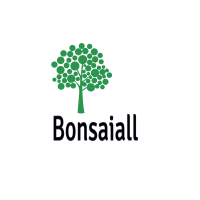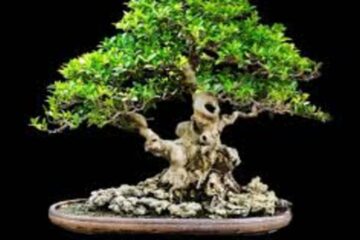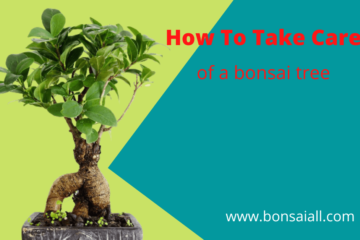Bonsai trees are a great way to add some natural beauty and charm to your home. If you’re a beginner, however, you might be unsure which types of bonsai trees for beginners are the best. In this article, we’ll provide you with a list of the best bonsai trees for beginners, based on factors like size, shape, and required proper care. We’ll also help you choose the perfect tree for your home, based on your preferences and surroundings. Ready to get started? Let’s go!
What is Bonsai Tree?
Content Overview
A bonsai tree is a miniature version of a traditional Japanese tree. Its name comes from the Japanese word for “tree in a pot”, as bonsai trees are typically grown in small containers. Generally, a bonsai tree is acquired by training it to grow in a specific shape and style, rather than waiting for it to naturally grow into that shape. This process involves pruning and shaping the tree so that it becomes aesthetically pleasing.
Selection of the types of bonsai trees for beginners
Caring for a bonsai does not have to be complicated, but if we choose a very demanding species it will undoubtedly be since we will have to be very aware of the plant, how the climate affects it, and take steps to keep her well. That’s why it’s highly recommended, especially if you don’t have a lot of experience, to start with tough trees, like the ones we ordered from least to most difficult:
Native plant species
Species of plants, especially trees and shrubs, typical of the area where you live are ideal for beginners. You don’t have to be worried about whether they’re hot or cold since they’re used to the weather.
In fact, the only thing you will need to think about is where you are going to put them, and of course, frequent watering, fertilizing, and regular pruning of them whenever necessary.
Some examples of bonsai from plants native to the Mediterranean USA would be:
1. Ficus Bonsai trees
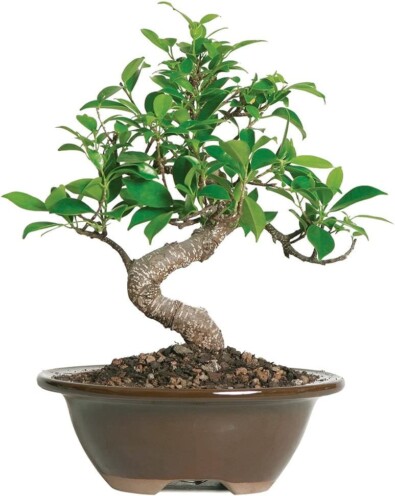
Image Credit: amazon.com
These are first on our list because these are, by far, the best types of bonsai trees for beginners that we have found. The ficus, also known as the fig tree, is a hardy and adaptable evergreen that requires high humidity and plenty of light. It can tolerate lower humidity and less light than most other houseplants.
Ficus Benjamina and Ficus Retusa are two of the most common varieties of ficus. These magnificent trees can produce fruits of all colors and are easy to grow. Some of them can even produce flowers.
Ficus are known for their vibrant green leaves with pointed tips, and they will add a splash of color to your home with their bright green foliage.
2. Bonsai Carmona
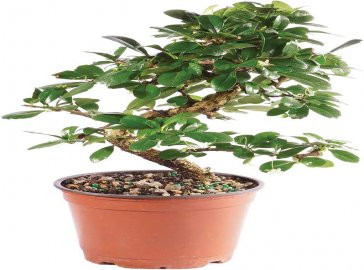
Image Credit : Amazon.com
Carmona bonsai is known as Fukien Tea bonsai trees. This type of bonsai is a very popular bonsai tree for beginners not only for its ability to thrive indoors but also for the small white flowers that bloom all year round and the red fruits it produces.
However, while this plant thrives well indoors in bright light, it is otherwise recommended to be given some sun exposure outdoors during the spring and summer months. I think Carmona has perfect types of bonsai trees for beginners
3. Schefflera Bonsai
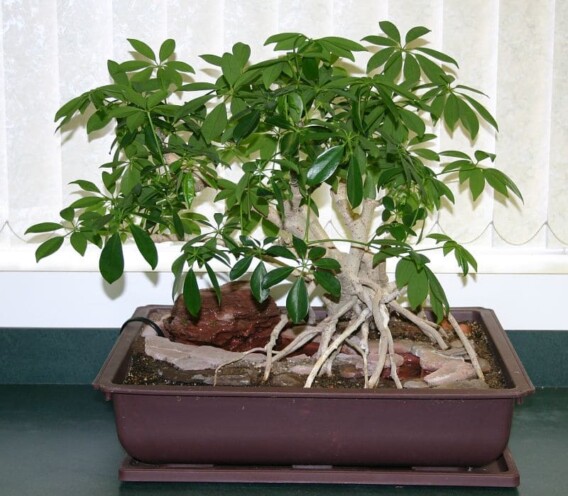
The Schefflera, also known as the dwarf umbrella tree, is a small tree with slender trunks and a dense canopy of leaves (hence its name).
Like the ficus, these plants tolerate low light and low humidity well; however, they don’t respond well to wiring, so if you want a plant you can mold and train, look elsewhere. these are the best types of bonsai trees for beginners.
4. Chinese elm bonsai tree/ Ulmus parvifolia
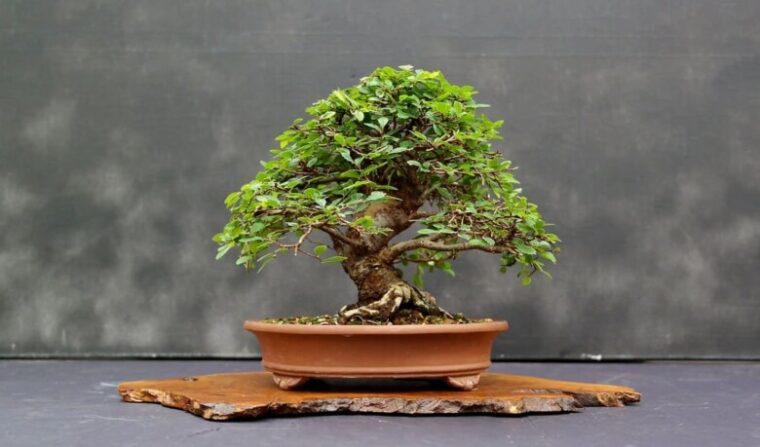
When you think of a classic bonsai, Ulmus parvifolia is most likely the first thing that comes to mind.
These are also excellent types of bonsai trees for beginners, as it grows quickly and can be adapted to your needs through pruning and training. In addition, in case of excess or lack of water, the consequences are not as serious as with other types.
5. Bonsai Crassula (Jade plant).
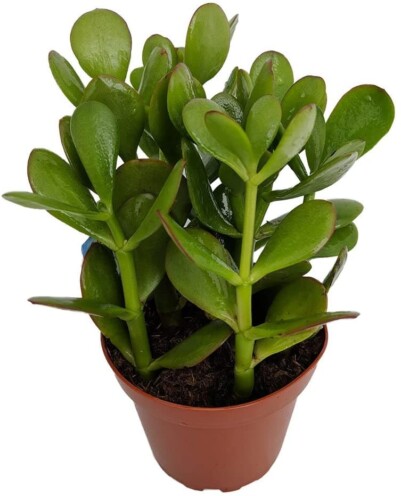
Credit: Amazon.com
As a shrub-like indoor bonsai, it has a thick trunk and leaves, and is sensitive to cold, making it an excellent choice for indoor growing.
Don’t overwater jade bonsai and make sure the pot you’re growing your tree in has plenty of drainage holes. If you want to start with bonsai Jade Bonsai trees are the best types of bonsai trees for beginners.
6. Bonsai serissa (Serissa Japonica)
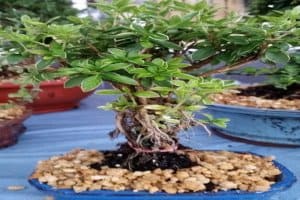
Credit : Amazon.com
Finally (because we could go on for a long time), the indoor bonsai Serissa Japonica is known for its amazing little white flowers that bloom in spring and summer. The Thousand-Star Tree, as it’s called, is our final recommendation because it’s more difficult to maintain than the other others.
Light and water levels, as well as changes in temperature and location, can all impact its behavior. It can be grown both indoors and outdoors, depending on the climate you live in, and it is a perennial. These types of bonsai trees for beginners are slightly difficult to care for.
7. Hawaiian Umbrella Bonsai
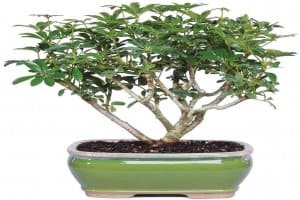
Credit: Amazon.com
They can adapt to a variety of light conditions and flourish in a variety of soil types. They do well even if you don’t water them on a regular basis, despite their dependence on consistent moisture.
Hawaiian umbrella trees are not just easy to maintain, but they also look stunning! The leaves are plentiful and deep green, and they spread out into a domed umbrella shape throughout the year.
They look fantastic when planted in groups and will happily grow alone in a pot. The slender trunks respond well to braiding with the correct instruction.
The Golden Hawaiian Umbrella Tree is a subspecies that is closely related. With the inclusion of colorful gold bands on the leaves, this bonsai possesses the same low-maintenance properties as its original counterpart.
8. Japanese Red Maple

Credit: Amazon.com
The Japanese red maple is one of the most popular best types of bonsai trees for beginners.
A deciduous tree grows quickly and produces a large number of leaves.
The Japanese red maple is a suitable bonsai tree for both indoor and outdoor cultivation, although it performs best when planted in a warm and moist environment.
Watering every two to three weeks during the summer months is all that is necessary for this species, making it one of the easier bonsai trees to care for.
9. Norfolk Island Pine
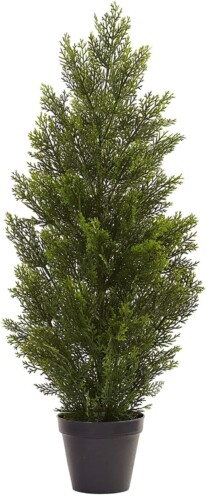
Credit: Amazon.com
Norfolk Island Pine Bonsai Tree (Araucaria heterophylla).
Norfolk Island pines are native to Australia and New Zealand. While they have been naturalized in the United States, these trees are still best suited for bonsai cultivation in their native region.
They are a relatively slow-growing, evergreen conifer that is not bothered by cool temperatures and are sturdy enough to be planted indoors during the winter.
Norfolk Island pine prefers temperatures above 50 degrees F and abundant bright light, which is not surprising for a semi-tropical species. The ideal location for your bonsai tree is a sunny, south-facing windowsill in a warm environment.
The Norfolk Island pine has a slow growth rate of about 3 to 6 inches per year, despite its natural height of up to 200 feet.
As a result, this makes it simple for first-time bonsai gardeners to keep their trees in tiny shape by trimming and repotting. These are the best types of bonsai trees for beginners.
10. Juniper Bonsai tree

Credit: Amazon.com
The Juniper Bonsai tree is one of the best types of bonsai trees for beginners. It can be grown in both indoor and outdoor environments. The juniper bonsai tree can grow well in different types of soil, such as peat moss mix, regular potting soil, or other types of soil that are rich with nutrients.
Juniper is a widely used evergreen hedge shrub that thrives in a range of ecological settings when grown naturally. The hardy characteristics of a juniper bonsai, as well as its ease of cultivation, are similar to those of the naturally occurring counterpart.
Juniper thrives in an open environment. You may keep your bonsai indoors for a few days at a time if the weather isn’t favorable. In the spring, summer, and autumn, it favors partial afternoon shade and morning light, while in the winter dormant stage, it prefers cool but protected conditions.
11. Flowering Ligustrum

Credit : Amazon.com
Ligustrum japonicum-Medium(Ligustrum Japonicum)
The Flowering Ligustrum Bonsai tree is one of the best types of bonsai trees for beginners. Flowering Ligustrum, also known as Japanese privet or Chinese privet, is a popular houseplant. It’s fast-growing and can be trimmed and shaped into a bonsai when it’s fully grown.
The Japanese privet prefers bright, filtered light but tolerates direct sunlight indoors. Flowering Ligustrum grows very quickly in warmer temperatures so provide proper ventilation by keeping the soil at a drier state or remove any excess water from time to time using paper towels or sticks as well.
They like moist, mildly acidic conditions (pH 6-7) so keep the soil moist, but not wet. In very cold climates, you can bring it indoors for the winter and plant it back out in spring or summer as soon as air temperatures rise above 50 degrees F.
12. Fruit Bonsai trees
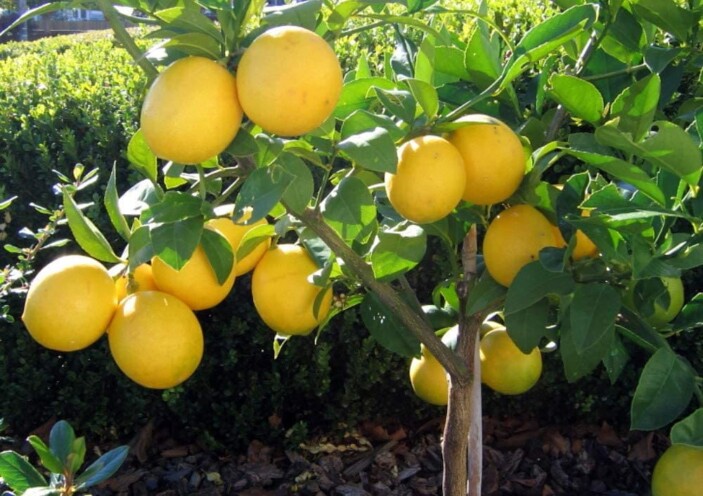
Apple trees, orange trees, lemon trees, and kumquats, of them, can be valuable bonsai trees if they are properly cared for.
You just have to keep in mind that they need sun, and some like the apple tree need frost in the area to be able to rest. Citrus fruits are generally sensitive to cold but can tolerate temperatures as low as -4°C.
As a substrate Akadama can be used alone or even mixed in equal parts with peat or a universal substrate.
Of course, you must try to avoid drastic pruning: it is better to prune the branches a little each time, rather than removing several in a single year.
These are the ones we recommend may be that the best types of bonsai trees for beginners’ bonsai journey.
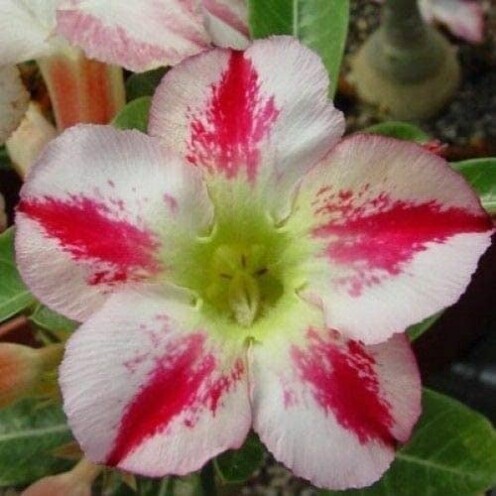
Credit: amazon.com
A flowering succulent with a bulbous base, which makes it look like a bonsai due to its roots and appearance… But with very pretty flowers! This indoor bonsai does not seek much care, although it does need a sunny window to maintain its flowers.
Growing tips: Provide as much sunlight as possible so that the flowers are always perfect. These are the most preferable flower types of bonsai trees for beginners.
14. Money Plants

Credit: Amazon.com
As well as being pretty. This beginner bonsai is considered a sign of good luck! And as if that were not enough, it is easy to maintain and does not need much to get ahead.
Cultivation tips: Do not water excessively and place it near a point of light. For starting the bonsai journey, these are the best types of bonsai trees for beginners.
Are Bonsai Trees Easy to Take Care of?
Bonsai trees are unique in that they require a certain amount of care, but they also provide their owners with a sense of pride and accomplishment. The knowledge you gain from caring for your bonsai tree will last a lifetime!
Every Bonsai tree care is not easy but most of them are quite the same. You have to care for your bonsai tree by the following thing :
1. Soil
Bonsai trees are generally grown in soil that is either organic or a mix of organic and artificial.
Organic bonsai soil usually contains no more than 2% peat moss, while artificial bonsai soil often contains up to 20 % peat moss (Yes, it’s one of the main ingredients!)
However, there are many different kinds of artificial soil available on the market nowadays. Most pure synthetic Bonsai soils are light and provide watering after rain. However, some companies may include stones in their products which would make it impossible to wash down quickly. Note: Do not use organic bonsai soils mixed with other ones unless you have consulted an expert about your choice!
2. Sunlight
While the bonsai tree’s miniature size means that it doesn’t need as much sunlight as a full-sized tree, you still want to give it at least six hours of direct sunlight every day.
If your tree gets too little light, it may suffer frost damage at the tips of its branches. Also, your bonsai tree will not thrive if you have no direct sunlight in its living area for a week or two
Adequate lighting is crucial to plants that grow Bonsai trees and can lead to poor development and a weak appearance on the trunk (known as deadwood). It also helps stop branch buds from dying back completely.
3. Water
Bonsai trees are notoriously finicky about their water, especially when it comes to the temperature of the liquid.
This is a result of their compact root structure and high evapotranspiration rate. In other words, they need water more often than other varieties of plants.
As a Bonsai beginner, you need to know how much water your tree needs, how to water your bonsai tree, and when it is acceptable for them to go dry (within several days) – this means paying attention during the summer months as they are more susceptible). The rule of thumb is that regular watering should occur roughly once a week in winter/spring and twice each month at other times of the year.
4. Fertilizing
In the early stages of your bonsai tree’s life, you may need to apply to fertilize it every month or two. As your tree grows older and reaches its full potential, fertilizing less often is beneficial for maintaining its health. If your tree starts leafing out again, you may want to add extra liquid fertilizer. It must be completely dry before hanging it upside down (after the needles have laid) because this can weaken and kill the foliage if watered too intensely beforehand
Bonsai trees require a similar level of light as sunlight but without intense heat drying excess nutrients are toxic. The plant combines elements in their natural environment with what they get from humans thus making them very easy.
5. Pruning
Pruning is the process of removing branches, branches, and sometimes even whole trunks from a bonsai tree. Pruning also involves thinning out the foliage to enhance its shape and reduce the overall size of your bonsai.
There are certain times of the year during which you might want to prune, such as when leaves drop too early in spring for example. Pruning can be very messy; a lot of goop will end up on your floor, but it is extremely important for all trees that your goal is to achieve a spectacular bonsai aesthetic.
6. Repotting and Root Trimming
To keep your bonsai healthy and thriving, you’ll need to repot it every 2 to 3 years.
To do this, dig up the soil from the bottom of your bonsai pot and gently remove any rocks or roots at the same time. Pour in new soil and water before placing your bonsai back in its usual spot at home, or into a slightly larger pot if space is an issue for you.
Root Trimming must be done on special occasions to ensure that all of the roots are entirely healthy and no pruning has damaged them with any dead parts or sapwood. This will only take 15 minutes from start to finish which cuts out excessive fuss around the home and ends up saving you much time.
Which Bonsai Tools Do You Need as a Beginner?
The quality and simplicity of your bonsai care are greatly improved by having the appropriate tools.
For example, you may trim your bonsai with a pair of regular scissors or clippers. However, your bonsai may be scarred, severely weakened, or even dead if you follow this strategy.
As you can see, using the right equipment is necessary for any task! The following are the bonsai you’ll need to take care of:
Concave branch cutter.
During structural pruning, you’ll need a concave branch cutter to make clean, easily healing incisions to your bonsai’s limbs and branches.
Spherical knob cutter.
Knobs and young shoots are safely removed from your bonsai’s trunk with a spherical knob cutter.
Bonsai shears.
Bonsai shears assist you to clip away buds and fresh foliage without disturbing the rest of your tree because of their long, thin design.
Single point root rake.
For repotting your bonsai, a single-point root rake helps you safely and gently dislodge it. To untangle small roots and remove surplus soil, you’ll utilize your root rake.
Moisture meter.
While you’re learning how to water your bonsai properly, a soil moisture meter isn’t absolutely required.
You might want to choose an all-in-one tool kit to make things a bit simpler. These kits provide everything you’ll need to begin your bonsai practice and, as you gain experience over time, you may add more specialized tools.
Bonsai Buying Guide
If you have any doubts about which one to choose, it’s time for us to give you some advice so that you have a better chance of getting the one you want:
Indoor or outdoor bonsai?
This question is misleading because indoor bonsai trees do not exist. What happens is that some species are not frost-hardy, so they need to be protected in a greenhouse or indoors. One of them is the Serissa Phoetida, which is a very beautiful tree but quite difficult to maintain in temperate regions precisely because of the frosts that occur during the winter.
If you are just starting out in this world, it is strongly recommended that you opt for resistant species, such as the ones we have shown you above, since indoor bonsai, even tropical ones, generally do not live for many years. inside. On the other hand, the ones we recommend are outdoor ones, capable of resisting low temperatures without any problem.
Price?
Today the price of bonsai is quite affordable (except for those that have been in operation for years or decades, which can be worth hundreds or even thousands of euros). But if you still don’t want to spend a lot of money, you always have the option of buying a pre-bonsai, or a small tree and working it as you wish.
Where to buy bonsai?
In the Amazon, you will find a wide variety of bonsai, of different species at very affordable prices. The advantage of buying here is that you can read the opinions of other buyers, so it’s easy to know whether people, in general, are satisfied with the products or not. Thanks to this information, you will only have to choose the one that you like the most. After you pay for it, you will receive it at home in a few days.
Thank you for reading our blog! In this post, we concluded our discussion on the best types of bonsai trees for beginners. We hope that you found it useful and that it helps you get started on the right foot with your bonsai tree cultivation journey! As always, if you have any questions or comments, feel free to leave them below. We would love to hear from you!
